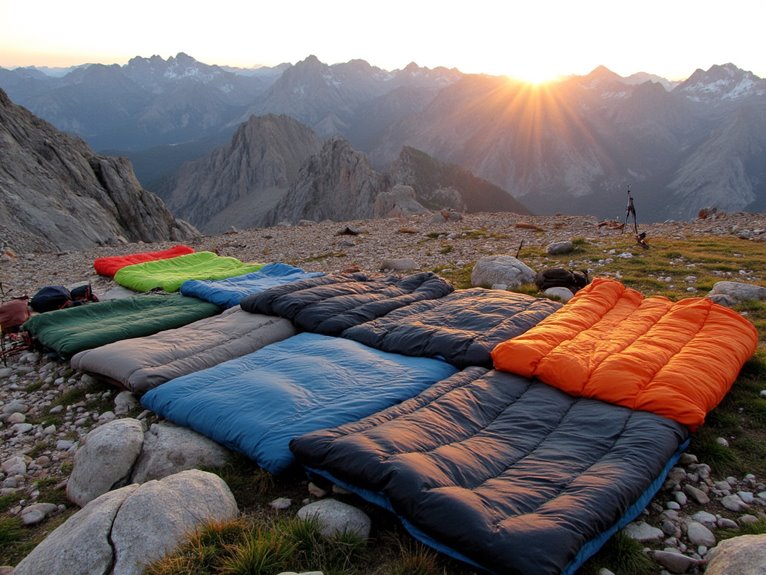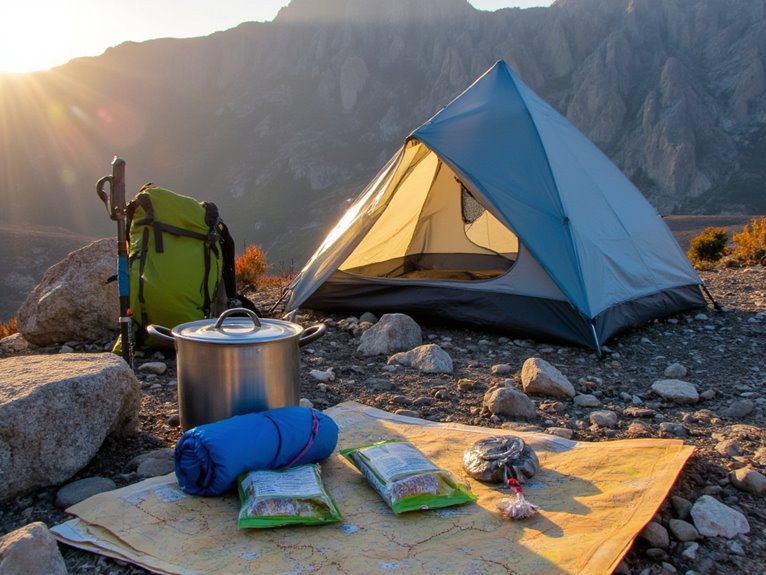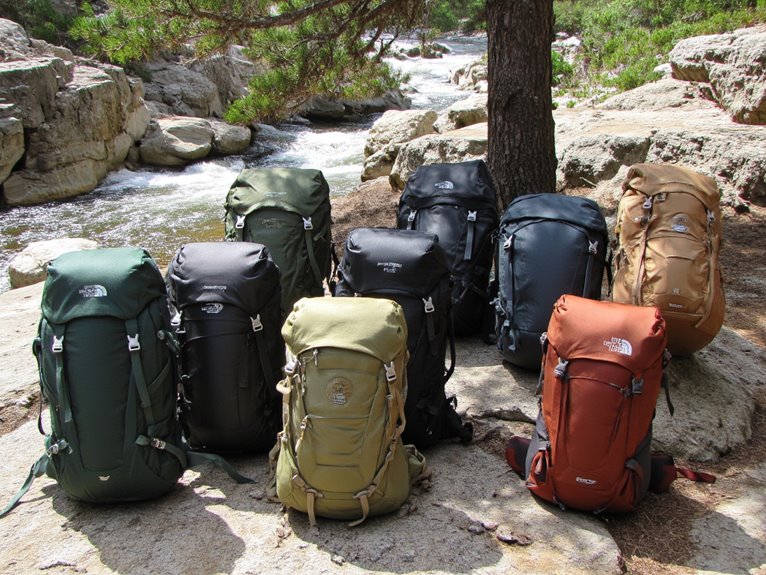Best Lightweight Backpacking Quilts for Your Next Adventure
I’ve tested dozens of lightweight quilts, and the best options balance warmth, weight, and versatility for three-season adventures. Top performers include the Ultralight Sleeping Bag Top Quilt at 1.9 pounds with 850-fill down and 30°F rating, the OneTigris Featherlite at just 35 ounces, and ZOOOBELIVES’s 27-ounce down bag with hydrophobic treatment. Quality quilts range from $50-250, featuring 650-850 fill power down, 20D ripstop shells, and pack sizes under 14 inches. The complete specifications and performance data below reveal which models excel in specific conditions.
We are supported by our audience. When you purchase through links on our site, we may earn an affiliate commission, at no extra cost for you. Learn more. Last update on 4th December 2025 / Images from Amazon Product Advertising API.
Notable Insights
- Top lightweight quilts weigh 1.3-2.3 pounds with 30-50°F temperature ratings, perfect for three-season backpacking adventures.
- 850 fill power down quilts offer superior warmth-to-weight ratios and compact packing compared to lower fill options.
- Quality quilts feature 20D water-resistant nylon shells, adjustable straps, and convertible footboxes for versatile sleeping configurations.
- Expect to invest $125-250 for reliable performance, with higher-end down quilts providing better long-term value and durability.
- Leading options include ZOOOBELIVES Ultralight (27oz), Onewind Hammock Quilt (2.3lbs), and ultralight top quilts under 2 pounds.
Ultralight Sleeping Bag Top Quilt 850 Down for Backpacking Camping
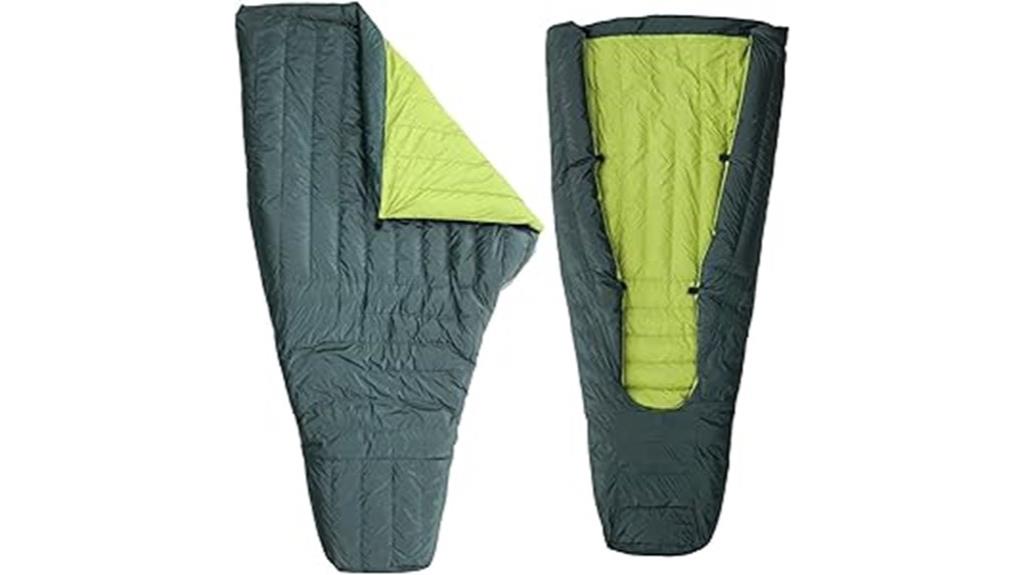
When you’re counting every ounce on multi-day backpacking trips, the Ultralight Sleeping Bag Top Quilt 850 Down delivers exceptional warmth-to-weight performance at just 1.9 pounds. The 850 fill power down provides superior insulation while the water-resistant 20D nylon shell protects against moisture. You’ll stay warm down to 30°F comfort rating and survive temperatures as low as 20°F.
The foot box design allows natural movement while maintaining warmth. Customizable ventilation lets you adjust airflow for temperature regulation. Included straps secure the quilt to your sleeping pad, preventing shifting during sleep. The compact 14×6.5×3-inch packed size fits easily in your backpack’s stuff sack.
Best For: Ultralight backpackers and hikers who prioritize weight savings and need reliable warmth for three-season camping in temperatures down to 30°F.
Pros:
- Exceptional warmth-to-weight ratio at just 1.9 pounds with 850 fill power down insulation
- Foot box design and customizable ventilation provide superior comfort and temperature regulation
- Compact packed size (14×6.5×3 inches) and included attachment straps for secure sleeping pad connection
Cons:
- Some users report inconsistent down distribution affecting warmth performance
- Requires a quality sleeping pad for optimal comfort and insulation from ground cold
- Limited to 30°F comfort rating, restricting use in colder winter conditions
OneTigris Featherlite Ultralight Sleeping Quilt (40 Degree, 35oz)
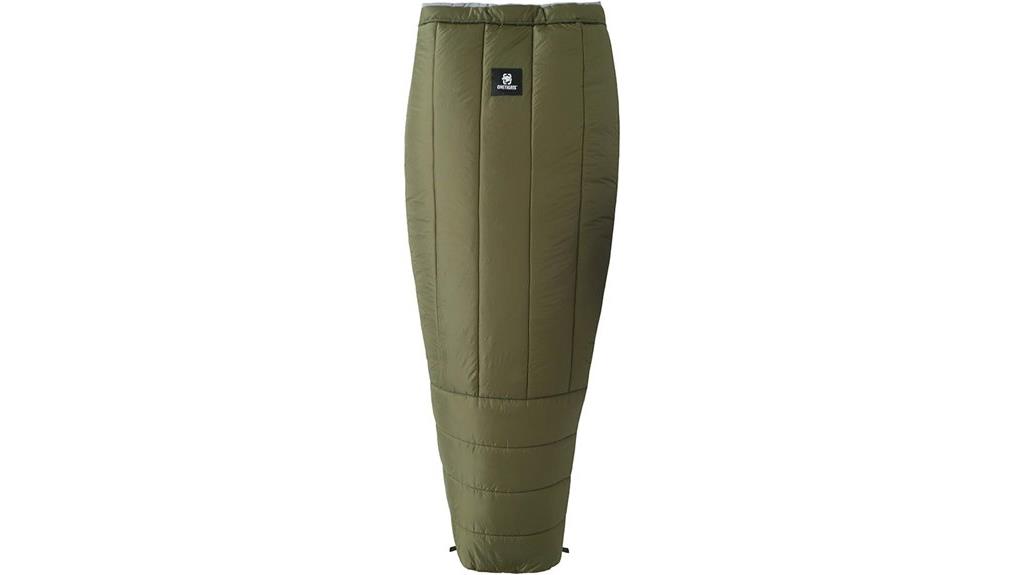
The OneTigris Featherlite Ultralight Sleeping Quilt delivers exceptional warmth-to-weight performance for ultralight backpackers who refuse to compromise on comfort during three-season adventures. At 35 ounces, this quilt provides 41°F temperature rating using SEE polyester fill. The 20D ripstop nylon shell and 380T polyester pongee lining create a durable yet packable system. You’ll appreciate the baffled construction that prevents cold spots while the hollowed back design accommodates your sleeping pad. The convertible footbox allows quick entry and exit while maintaining heat retention. This mummy-shaped quilt measures 6.5 by 2.8 feet and compresses to gallon-jug size. Users report effective warmth down to freezing temperatures, earning 4.6 stars from 428 reviews.
Best For: Ultralight backpackers and hammock campers who prioritize weight savings without sacrificing warmth during three-season adventures.
Pros:
- Exceptional warmth-to-weight ratio at 35oz with effective performance down to freezing temperatures
- Highly packable design that compresses to gallon-jug size for easy transportation
- Versatile convertible footbox allows quick entry/exit while maintaining heat retention
Cons:
- Some users report issues with the footbox design functionality
- Cinch cord at the head can be problematic according to user feedback
- Hollowed back design requires a sleeping pad for proper insulation from below
Horizon Hound Down Camping Blanket – Outdoor Travel Quilt
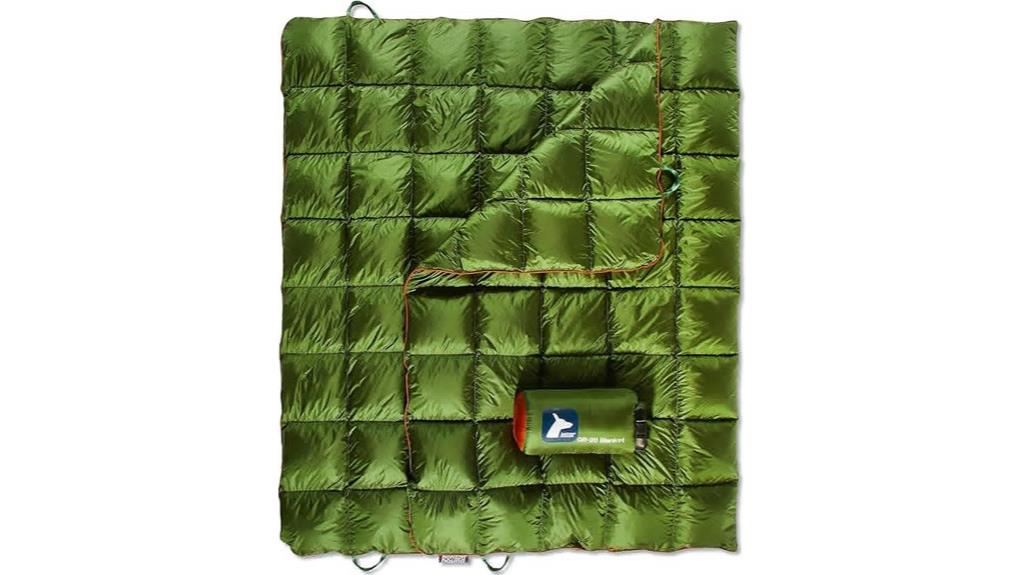
Backpackers seeking warmth without weight penalties will find exceptional value in the Horizon Hound Down Camping Blanket. This outdoor travel quilt features 650-fill down insulation that compresses to a loaf-sized package. You’ll experience effective warmth retention down to 45-50 degrees Fahrenheit. The water-resistant fabric protects against moisture while maintaining packability for extended trips.
Versatility defines this blanket’s design. Button snaps transform it into a wearable poncho around camp. You can use it as a sleeping bag alternative during spring, summer, and fall conditions. The lightweight construction suits long backpacking adventures without compromising warmth.
Quality concerns include down feathers occasionally escaping through fabric seams with extended use.
Best For: Backpackers and outdoor enthusiasts who need a lightweight, packable blanket for three-season camping and want versatility to use it as both bedding and wearable gear.
Pros:
- Compresses to loaf-sized package with 650-fill down insulation providing excellent warmth-to-weight ratio
- Button snaps allow transformation into wearable poncho for increased camp versatility
- Water-resistant fabric protects against moisture while maintaining effective warmth down to 45-50°F
Cons:
- Down feathers escape through fabric seams with extended use
- Not suitable for extreme cold weather conditions
- Limited to three-season use rather than year-round camping
Lightspeed Outdoors Sundown Camp Quilt, Camping Blanket, Teal
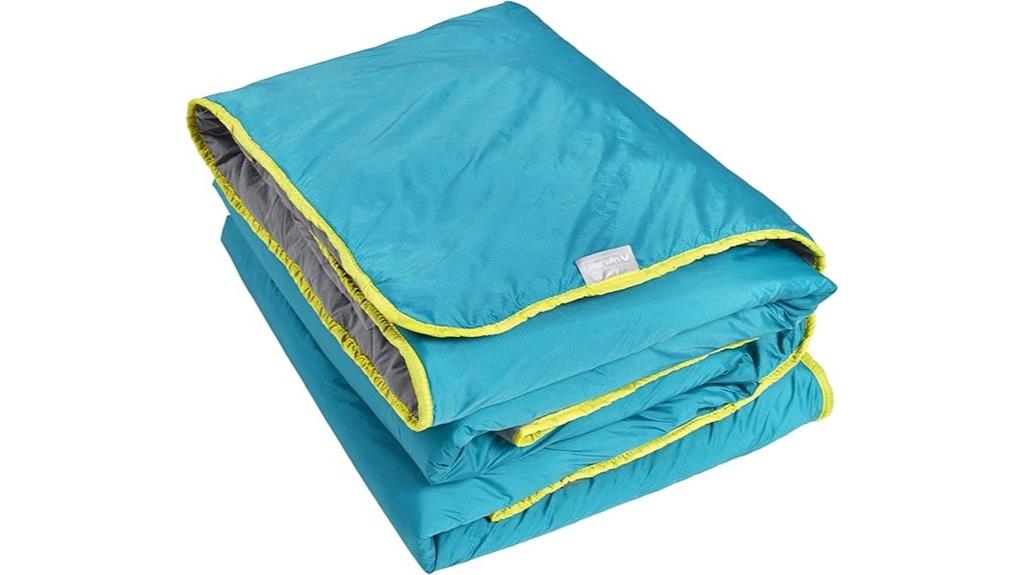
Anyone seeking a versatile camping blanket that bridges the gap between home comfort and outdoor durability will find exceptional value in the Lightspeed Outdoors Sundown Camp Quilt. This 77L x 55W inch blanket weighs just 2.82 ounces and features 20D water-resistant nylon construction. The material provides effective moisture and wind protection while maintaining softness against skin.
You’ll appreciate the integrated hand pockets that offer additional warmth retention during cold mornings. The included stuff sack with drawcord closure guarantees compact storage, while the corner storage pocket provides convenient organization. Machine washable care simplifies maintenance between adventures. Customer ratings average 4.4 stars across 126 reviews, indicating consistent performance satisfaction for car camping and outdoor events.
Best For: Car campers and outdoor enthusiasts who want a lightweight, versatile blanket that offers home-like comfort with weather protection for camping trips, outdoor events, and emergency situations.
Pros:
- Extremely lightweight at just 2.82 ounces with water-resistant nylon construction that blocks moisture and wind
- Thoughtful design features including hand pockets for warmth and multiple storage options with stuff sack and corner pocket
- Machine washable with strong customer satisfaction ratings (4.4/5 stars) indicating reliable performance
Cons:
- Adult-only use restriction (15+ years) limits family sharing opportunities
- Some reported design flaws with the teal side not being properly sewn to the batting
- Compact size may not provide sufficient coverage for taller individuals or couples
Down TopQuilt for Ultralight Backpacking
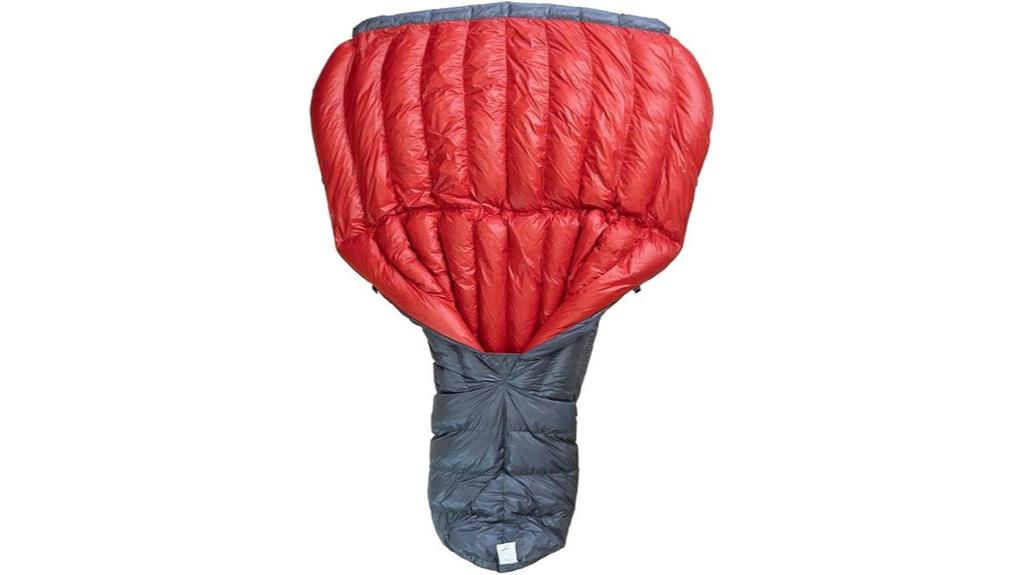
Outdoor Essentials’ Down TopQuilt delivers exceptional warmth-to-weight performance when every ounce matters on extended wilderness expeditions. This ultralight design weighs just one pound while providing 30°F temperature protection in a 76L x 56W inch mummy configuration. You’ll appreciate the 800+ fill power down with DWR treatment and hybrid baffle construction that optimizes thermal efficiency. The 10D nylon shell compresses remarkably small for pack-friendly storage. You can utilize the included pad strap for both ground camping and hammock configurations across three seasons. Users report effective warmth down to 10°F with additional layers, though some quality control concerns exist regarding down distribution consistency.
Best For: Ultralight backpackers and outdoor enthusiasts who prioritize weight savings and packability while needing reliable 3-season warmth for wilderness camping and hammock use.
Pros:
- Exceptional weight-to-warmth ratio at just 1 pound with 30°F temperature rating and 800+ fill power down
- Highly compressible 10D nylon construction that packs small for space-conscious backpacking
- Versatile design with included pad strap that works for both ground camping and hammock configurations
Cons:
- Quality control issues reported by some customers regarding uneven down distribution and fill gaps
- Mixed customer service experiences when addressing product concerns
- Down fill power may not consistently meet advertised standards according to some user reports
Onewind Hammock Top Quilt with Footbox for Camping and Hiking
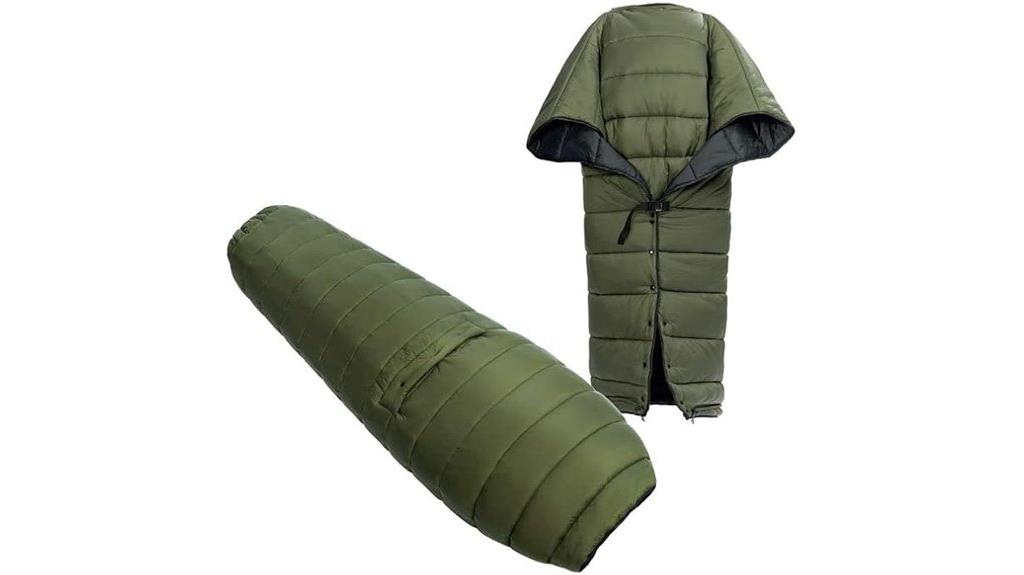
The Onewind Hammock Top Quilt with Footbox delivers exceptional versatility for backpackers who demand a single piece of gear that adapts to multiple sleeping scenarios. This 2.3-pound quilt transforms into a top quilt, comforter, wearable sleeping bag, or poncho. The 86 x 54-inch dimensions accommodate most users, though broader shoulders may find the width restrictive.
DuPont Sorona insulation provides reliable warmth down to 35-50°F, with practical testing confirming comfort to 45°F. The recycled nylon fabric features a durable water-repellent finish for wind and light rain protection. You’ll appreciate the cozy footbox design with adjustable airflow controls.
The compact 16 x 32 cm packed size makes transportation effortless. With 610 customer ratings averaging 4.5 stars, users praise its warmth-to-weight ratio and multi-functionality while noting snap quality concerns.
Best For: Backpackers and campers who want a versatile, lightweight sleeping system that adapts to multiple scenarios including hammock camping, ground camping, and cold weather conditions down to 45°F.
Pros:
- Exceptional versatility with 4-in-1 functionality (top quilt, comforter, wearable sleeping bag, poncho)
- Lightweight at 2.3 pounds with compact packed size for easy transportation
- Reliable warmth rating and DuPont Sorona insulation with water-repellent finish
Cons:
- Width may be restrictive for users with broader shoulders
- Snap quality issues noted by customers with snaps not extending full length
- Bulkier than some competing lightweight options like the Swagman Roll
Factors to Consider When Choosing a Lightweight Backpacking Quilt
I’ve tested dozens of lightweight quilts across different conditions, and choosing the right one requires evaluating five critical factors that directly impact your comfort and pack weight. Weight and packability determine how much space the quilt consumes in your pack, while temperature ratings establish the lowest safe operating temperature for your sleep system. The remaining factors—fill power, shell material durability, and size dimensions—work together to define the quilt’s overall performance and longevity in backcountry conditions.
Weight and Packability
When selecting a lightweight backpacking quilt, weight and packability rank among the most critical factors that’ll determine your comfort and mobility on the trail. I recommend targeting quilts weighing between 1.3 to 2.2 pounds for peak performance. This weight range provides excellent warmth-to-weight ratios without compromising comfort.
Packability matters equally. Quality quilts compress to sizes comparable to a gallon jug or loaf of bread, maximizing precious backpack space. Materials like 20D nylon shells paired with high-loft down insulation achieve this compression while maintaining durability. Look for quilts with dedicated stuff sacks that enable consistent packing.
Most lightweight options feature temperature ratings from 30°F to 50°F, perfect for three-season adventures. These specifications guarantee you’ll carry minimal weight while maintaining essential warmth and packability for extended backcountry trips.
Temperature Rating Systems
Understanding temperature rating systems becomes essential since manufacturers use different standards that can greatly impact your gear selection. I’ve found that most lightweight backpacking quilts feature two important ratings: comfort and survival temperatures. Comfort ratings indicate the lowest temperature you’ll sleep well at, while survival ratings mark the threshold for avoiding hypothermia.
Three-season quilts typically offer 30°F comfort ratings or 20°F survival ratings. Summer-specific models work above 50°F. Fill power notably affects performance—850-down provides superior insulation efficiency compared to lower ratings.
I can’t stress enough how individual usage varies. Customer reviews consistently show temperature performance differences between users. You’ll need a quality sleeping pad to maximize warmth retention, as ground insulation proves vital for achieving rated temperatures in real-world conditions.
Fill Power Options
Fill power directly determines your quilt’s warmth-to-weight ratio and represents the most critical specification for lightweight backpacking performance. Higher fill power down creates more loft per ounce, trapping air more efficiently for superior insulation.
850 fill power offers the best warmth-to-weight ratio available. You’ll get maximum compressibility and thermal efficiency, making it ideal for ultralight objectives and cold weather camping. This premium down compresses smaller and weighs less than lower grades.
650 fill power provides adequate warmth at lower cost but requires more material for equivalent insulation. You’ll need additional layers in colder conditions or accept heavier pack weight.
Hydrophobic treatments enhance performance in wet conditions. Treated down retains loft when damp, maintaining insulation properties. Most quilts rated for 30°F comfort use 800+ fill power to achieve adequate warmth without excessive bulk.
Shell Material Durability
Although down insulation gets most attention, your quilt’s shell fabric determines how long your investment will last in the field. I recommend 20D water-resistant nylon as the best balance between weight and durability. This denier rating provides sufficient thickness to resist abrasions while maintaining packability.
Ripstop construction is essential. The integrated grid pattern prevents small tears from spreading into gear-destroying rips during extended backcountry use. Higher denier fabrics offer increased puncture resistance but add weight—consider your typical terrain when choosing.
Water-repellent treatments protect the down insulation from moisture infiltration. These coatings maintain loft and warmth during unexpected precipitation. However, they require periodic reapplication.
Proper maintenance extends shell life notably. Avoid dragging your quilt across rough surfaces and follow manufacturer washing instructions precisely.
Size and Dimensions
When selecting a backpacking quilt, proper sizing directly impacts both thermal efficiency and pack weight. I recommend choosing quilts between 76 to 86 inches in length, matching your height for ideal coverage. Width typically ranges from 51 to 56 inches, providing adequate shoulder room without excess material.
Packed dimensions matter considerably for backpacking. Look for quilts that compress to 12-14 inches when stored. This compression ratio greatly improves pack organization and reduces bulk.
Shape affects performance greatly. Tapered designs save weight while rectangular options offer more movement freedom. I suggest considering your sleeping style when choosing between these configurations.
The footbox design is essential for warmth retention. This enclosed foot area prevents heat loss while accommodating natural foot positioning. Quilts without proper footboxes compromise thermal efficiency, making this feature non-negotiable for serious backpackers.
Attachment System Design
Beyond proper sizing, the attachment system determines how effectively your quilt performs throughout the night. I recommend choosing quilts with adjustable straps or loops that secure directly to your sleeping pad. These systems prevent shifting that causes cold spots and heat loss.
Most quality quilts feature customizable attachment points. You can adjust tension and positioning based on your sleeping style. Side sleepers need different configurations than back sleepers. The best systems allow quick entry and exit without the restrictive feeling of traditional mummy bags.
Look for compatibility between your quilt’s attachment method and your sleeping pad design. Some systems use elastic loops, others use snap buckles or drawcords. Adjustable features let you control ventilation and insulation levels as temperatures change throughout the night.
Versatility and Features
The most adaptable quilts transform from single-purpose sleep systems into multi-functional gear that earns space in your pack. I look for designs that function as top quilts, comforters, wearable sleeping bags, or ponchos. This versatility maximizes utility across different camping scenarios.
Customizable ventilation features prove essential for temperature regulation. You’ll want adjustable airflow options for warmer nights and secure closure systems for cold conditions. Adjustable footboxes enhance heat retention while providing quick entry and exit access.
Material selection directly impacts performance. Lightweight fabrics with water resistance maintain durability without adding pack weight. Quality quilts include attachment straps that secure the system to your sleeping pad, preventing shifting during sleep. These features collectively determine whether a quilt performs reliably across varied outdoor conditions and camping styles.
Price Point Analysis
Price considerations often determine which quilt features you’ll realistically access in your gear selection. I’ve found that lightweight backpacking quilts typically range from $50 to $250, depending on materials and construction quality. You’ll pay premium prices for 800+ fill power down insulation, which delivers superior warmth-to-weight ratios and compressibility. Budget around $125 for a well-reviewed three-season quilt that balances performance against cost effectively.
Advanced synthetic insulation and specialized design features command higher prices. Custom options and patented technologies increase costs markedly. I recommend timing purchases during off-peak camping seasons when manufacturers offer substantial discounts. Higher fill power down quilts cost more upfront but provide better long-term value through superior performance and durability characteristics.
Frequently Asked Questions
How Do I Properly Care for and Wash My Down Backpacking Quilt?
I recommend washing your down quilt every 10-15 uses. Use a front-loading machine with cold water and down-specific detergent like Nikwax Down Wash. Never use fabric softener or bleach. Add tennis balls during the rinse cycle to prevent clumping. Dry on low heat with dryer balls, checking frequently. The process takes 2-3 hours. Store uncompressed in a large cotton bag to maintain loft.
Can Backpacking Quilts Be Used in Hammocks Effectively?
I’ll tell you that backpacking quilts work exceptionally well in hammocks. They’re actually superior to sleeping bags for hammock camping. You’ll wrap the quilt around your entire hammock system, eliminating the compression issues that plague sleeping bags underneath you. The quilt’s open design allows proper coverage of your sides and feet while maintaining loft. Most quilts include attachment points specifically designed for hammock suspension systems.
What’s the Difference Between Down Fill Power Ratings Like 650 Vs 850?
I’ll explain fill power ratings directly. Fill power measures down’s loft capacity – how much space one ounce occupies when fully expanded. 650 fill power means one ounce fills 650 cubic inches, while 850 fill power expands to 850 cubic inches. Higher numbers indicate superior insulation efficiency. You’ll get more warmth per ounce with 850-fill down, creating lighter quilts with identical temperature ratings compared to 650-fill alternatives.
How Do I Prevent Cold Spots When Using a Quilt Instead of Sleeping Bag?
I’ll address cold spots by securing your quilt’s perimeter properly. Use the attachment system to connect your quilt to your sleeping pad’s edges. Tuck the foot box tightly around your feet. Pull the quilt under your shoulders and torso to eliminate air gaps. Choose a quilt width that matches your sleeping pad dimensions. Draft collars prevent warm air from escaping around your neck area.
Are Synthetic Fill Quilts Better Than Down in Wet Conditions?
Synthetic fill quilts outperform down in wet conditions. I recommend synthetic options when you’ll encounter high humidity or rain. Down loses 90% of its insulation when wet and takes hours to dry. Synthetic materials like Climashield or PrimaLoft retain 80% of their warmth when damp and dry three times faster. You’ll stay warmer if unexpected moisture hits your gear during the night.
On a final note
I’ve analyzed the top lightweight backpacking quilts based on weight-to-warmth ratios, temperature ratings, and packability metrics. Each option offers distinct advantages for specific conditions and user preferences. The 850-down models provide superior warmth-to-weight performance, while synthetic alternatives deliver reliable insulation in wet conditions. Consider your typical camping temperatures, pack weight limits, and budget constraints when selecting your ideal quilt. These recommendations will enhance your backcountry sleep system efficiency.

